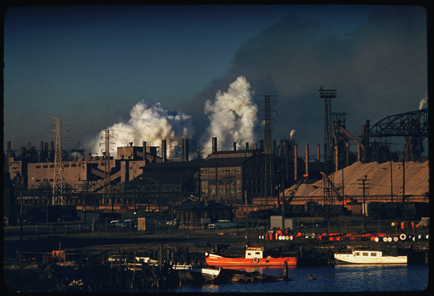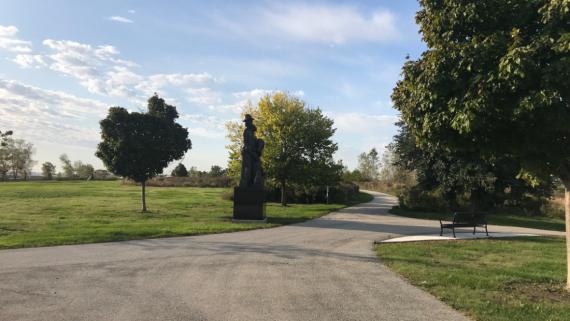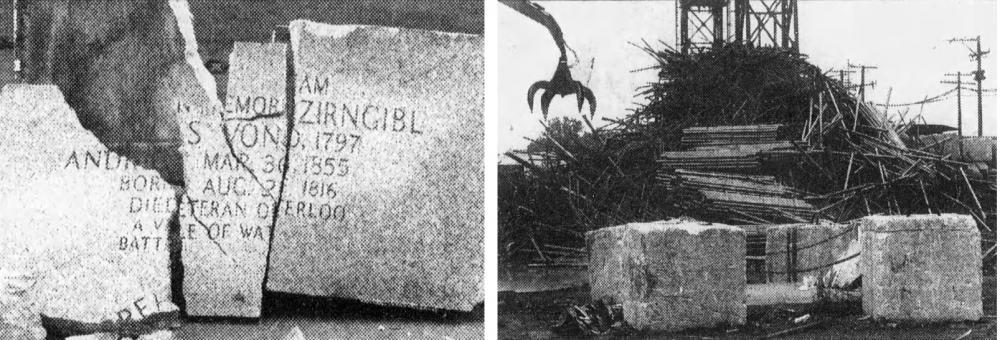Fiercely Proud of Their Home, Residents of Chicago's Southeast Side — Long a Toxic Dumping Ground — Are Rising up Against Polluters
In Far Southeast Side Hegewisch, a row of modest single-family homes and two baseball fields sit less than a mile from mountainous heaps of petcoke to the east and day-glo yellow piles of sulfur to the west.
Among the scores of blocks hugging the Indiana border, the Chicago Skyway and the Calumet River are decrepit steel and concrete structures and old factories that are dank reminders of the area’s glory years as the gateway to Big Steel.
Roman Villarreal, 71, a second-generation steelworker, artist and mentor, grew up in a rough-and-tumble section of South Chicago known as “The Bush” and lived across the street from the South Works mill.
“We grew up with the noise, the sound ... the graphite. I remember playing in it. We called it the silver rain,” recalled Villarreal.

U.S. Steel South Works, Chicago Charles Cushman, Indiana University Archives, 1958.
The jobs at the mighty U.S. Steel South Works and Wisconsin Steel mills, among others, paved middle-class lifestyles from South Chicago to Gary for generations of European immigrants, before the arrival of Mexican and Black workers in the early 1900s.
Today, their descendants remain in the old mill neighborhoods, some in the same homes their parents or grandparents purchased with their mill earnings.
But a toxic legacy remains.
Generations of steel and chemical manufacturing in the region have contaminated vacant industrial land that has sat dormant since the businesses shuttered. The Southeast Side remains home to various industries that produce waste materials affecting the area’s air, land and water: sewage treatment, refuse and garbage plants, incinerators, landfills, chemical and food processing facilities, industrial chemicals, asphalt and natural gas production, trucking and shipping yards, to name a few.
The residents of the Southeast Side are fiercely proud of their home. And they say they are tired of being the city’s dumping ground, so they are fighting back.
In one high-profile case, a former North Side scrap shredder is embroiled in a controversial proposal to reopen in the East Side neighborhood.
“This area will accept any company. Any (Environmental Protection Agency) violator with a checkbook is welcome down here, and that’s a humongous problem,” said South Chicago native and music producer Julio Ibarra, 36, who is hoping the younger generation will revitalize the area with art and music.
“That could be the most unethical thing on the planet to take a shredder from a wealthy North Side neighborhood and to stick it across the street from a high school and a grade school,” said Ibarra, who has a 6-year-old son. “These kids, they’re not even being given a chance.”
Reserve Management Group bought the Lincoln Park shredding operation from General Iron Industries before it was closed in December. The company’s attempt to open a new facility near a high school has drawn a coalition of longtime residents, young activists and artists banding together for news conferences, an organized hunger strike and a caravan of more than 30 vehicles touring toxic sites near the former locations of steel mills and factories.
Countless studies, including one from a coalition of public health and environment groups, found that the Calumet area had higher rates of coronary heart disease, asthma and some cancers than any other part of the city. The health problems persist in an area underserved by medical facilities.
“(The city’s East Side) has carried the burden for us. It’s easy for us to look away. Many of us just drive by on the expressway and don’t really know what’s behind that big mound or that old industrial building that we see,” said Juanita Irizarry, executive director of Friends of the Parks.
Some activists and concerned residents are hopeful that the RMG fight, which now involves accusations of environmental racism and a federal investigation into city and state permitting, will build momentum that could spread to other major areas of environmental concern.
One such battle is the toxic sludge tank at Calumet Park at the mouth of the Calumet River. The U.S. Army Corps of Engineers is reneging on an agreement to remove the tank and convert the area into a community park.
Built in 1984, the facility is a disposal site for toxic sludge dredged from the Calumet River and the Cal Sag Channel. The Illinois General Assembly allowed the Army Corps to use it with the idea that, once full, it would be topped off and handed over to the Chicago Park District for redevelopment as a park.
The Army Corps’ change in plans has angered some residents convinced that city, state and federal authorities are content to ignore the area as other parts of the city enjoy expanded green spaces.
Marie Collins-Wright, a retired state worker and longtime South Deering resident and activist, said she’s used to the racial politics that came with living so close to the 10th Ward, formerly a white ethnic stronghold but now predominantly Latino.
Environmental problems such as the sludge tank stretch across economic and racial lines, she said. “It’s bigger than even race. This city belongs to all of us. If they were doing this in Indiana or Michigan, we’d be having a fit. ‘Why are they doing this?’
“But we sit back and trust them,” Collins-Wright said. “Why would we trust them?”
Collins-Wright and other residents believe now is the time to educate the rest of the city about the Southeast Side.
Made up of a patchwork of residential and industrial plots, wetlands and Rust Belt communities with their own slang and customs, this corner of Chicago has its own identity.
‘Sharing the American Dream’
Old-timers who are still around call parts of the neighborhood by their old names unfamiliar to other city dwellers: South Deering. Slag Valley. Veteran’s Park. Trumbull Park.
For years, European immigrants took a familiar path: Most started families in modest, working-class neighborhoods like South Chicago and South Deering before moving on to the city’s East Side neighborhood, home to city and local union workers, or to rapidly expanding northwest Indiana.
But the East Side of that time was a very insular world that could be downright hostile to Black and brown neighbors.
“What’s interesting here about growing up in the ’50s, you couldn’t go to the East Side. It was strictly segregated,” Villarreal recalled. “You had to be a really tough Mexican to go to the East Side, because they were rough.”
Marcelina Pedraza, a fourth-generation Southeast Side resident and Ford Motor Co. electrician, said her great-grandfather, grandfather and dad all worked for the mills. Her father worked at three area mills until illness slowed him. He died at 41 when Pedraza was 9.
“You had these good-paying jobs. You don’t necessarily have to have a degree or high school diploma, even. You didn’t even have to know English,” Pedraza, 45, said in her East Side home. “My grandparents knew English, but he didn’t need to to do the work he was doing. He was a boilermaker at the mills, like a dirty, gruntlike job.
“But he was able to provide for his family. Send all of his kids to Catholic school, buy a multiunit house and two plots of land,” Pedraza said. “Coming from Mexico that’s kind of a big deal.”
The closure of the mills meant the first unemployment many in the community had ever experienced. Many families had to go on welfare, a bitter pill in a working-class bastion where work provided dignity as well as a livelihood.
“When it was gone, people lost their houses, their cars, and it just wasn’t enough to provide. I know my family struggled just when my dad was laid off and he got sick,” Pedraza said.
As good friends and close neighbors moved away or died, Villarreal and his wife, Maria, have remained in his family’s South Chicago apartment, where art literally covers any clear surface.

Steel Workers Park, Chicago, looking South - Chicago Park District
One of his works, called Tribute to the Past, is a towering bronze statue at Steelworkers Park, the site of a demolished mill, and honors the hard work and sacrifice by immigrant families like his.
Villarreal, who hopes to convert the once thriving Commercial Avenue shopping district into an arts hub for visual artists, muralists and homegrown musicians, clearly remembers the life mill work provided his family.
“We were almost there, sharing the American Dream. We were almost middle class,” he said inside his Commercial Avenue art studio. “They (mill owners) had made a deal with Ford and everybody was buying cars. It was a time of plenty, until that dreadful day when everybody showed up at work and the mill was closed. And it was all over. The end of an era.”
‘Tired of being the dumping ground’
The skies over Southeast Chicago are no longer black with metallic soot, though it can darken with the heavy semitruck exhaust, and the skies shimmer from the toxic releases from nearby refineries.
Frequent drivers along the Bishop Ford Freeway know to roll up their windows before the pungent sewage smell from the adjacent treatment plant whiffs into their vehicles.
Ibarra knows the experience. “You’re driving and then all of a sudden salt starts whizzing by your car. You have to roll up your window because of (the) landfills’ disgusting smell. Especially around 100th and Torrence (Avenue). It smells putrid over there.”
According to a comprehensive report by the nonpartisan Alliance for the Great Lakes, the area is home to one of the largest industrial footprints in the region and several businesses classified as high polluters. Known as the Calumet Industrial Corridor, it has a rate of coronary heart disease and chronic obstructive pulmonary disease higher than the rest of Chicago.
“I saw the negative impact of industry,” said Ibarra’s wife, Gina Ramirez, a third-generation Southeast Side native and Midwest outreach manager for the Natural Resources Defense Council. “My mom has asthma really bad and a variety of autoimmune diseases. She grew up right by U.S. Steel.
“We’ve been desensitized because we’ve been around it so long. You kind of ignore even the foul odors,” said Ramirez, 38, whose father and grandfather worked in the mills. “I think people have enough pride in the neighborhood that they will fight like hell for it, and that’s what wakes me up and motivates me every day.”
Her husband said the Southeast Side’s problems extend beyond the neighborhood.
“We’re tired of being the dumping ground,” said Ibarra. “The thing is, even though this is a very remote area from the city — not a lot of people know it — our problems are global and macroeconomic in scale.”
‘Totally very tribal’
The Chicago Skyway bridges escorting millions of people over the Southeast Side are both a blessing and a curse for the community. Bridges and viaducts isolate the community, shielding it from prying eyes, while helping it preserve its steel and factory town culture that’s more industrial than urban.

LEFT: The marker after a crane operator accidentally broke it.
RIGHT: Andreas von Zirngibl’s resting place, protected by concrete barriers, lies amid stacked metal at Scrap Processing Inc. in 1999.
Chicagology
Fiercely independent, the Southeast Side has its own downtown areas, its own historical society, noteworthy schools, landmarks, rivalries. It even has its own lingo.
“It’s totally very tribal. We kind of hate that people don’t know our neighborhood but actually secretly love it because we have our own little things that we talk about,” said Ramirez.
“They talk Hienie’s Hot Sauce. We have our alphabet streets (Avenues A-O),” she said. “Calumet Fisheries is like a huge restaurant that people know about. But people in my neighborhood say, ‘I’m going to go to get fish from the bridge.’”
In recent years, South Chicago has slowly become a destination to view murals.
A green “Steel City” sign hangs near the mouth of the southwest entrance to viaducts in the 9300 block of South Commercial Avenue. Both sides are showcases to street art: a cartoonish robot, a skeleton wearing a robe of city colors, vivid surreal images with hidden messages.
Ibarra also wants to rekindle the community’s underground rock music scene and helped produce a documentary on Southeast Side drummer and local rock legend John Munoz.
Committed to the community
Collins-Wright, the former state worker, saw an opportunity when she bought her home in South Deering in 1985, following the fall of the mills. Having always lived along the lakefront and having spent a decade on the North Side, she thought it was the perfect time to buy.
“I had a child and I didn’t want my child to grow up in a high-rise. I wanted my child to be able to go out into the yard and play.”
Ibarra and Ramirez say they’re committed to staying in the community, building a new future free of the toxic industry past.
“I love the calmness of the neighborhood. It’s like a small-town feel,” Ibarra said. “We honestly do know just about everyone we’re (neighbors) with — literally hundreds of the people from the area. There’s no reason to leave them behind at all.”
William “Will” Lee has been a reporter with the Chicago Tribune since July 2009. Since then, Will has covered cops, courts, politics and entertainment, reviewing video games and interviewing celebrities. He also worked as a legman to Page 2 columnist John Kass. Will covered similar topics for the SouthtownStar and the Daily Southtown.


Spread the word